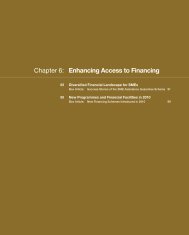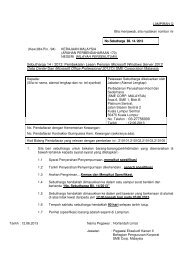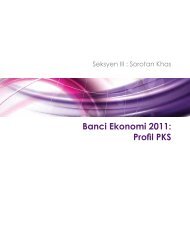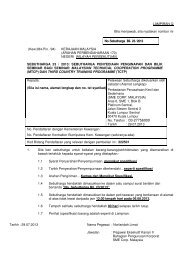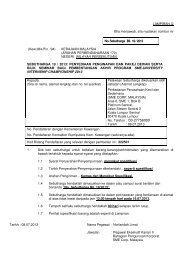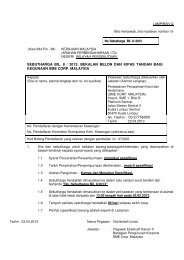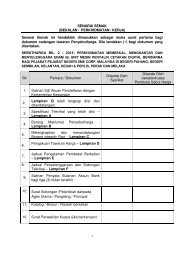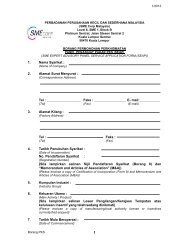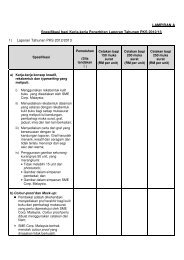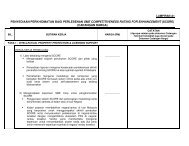Chapter 1 - SME Corporation Malaysia
Chapter 1 - SME Corporation Malaysia
Chapter 1 - SME Corporation Malaysia
- No tags were found...
You also want an ePaper? Increase the reach of your titles
YUMPU automatically turns print PDFs into web optimized ePapers that Google loves.
National <strong>SME</strong> Development Council<strong>SME</strong> ANNUAL REPORT 2009/109CHAPTER 1households and businesses grew cautious of the deterioration in externaldemand, weaker labour market conditions and overall decline in private sectorsentiment. Domestic demand stabilised since the second quarter as the resultof the Government’s accelerated implementation of the two fiscal stimuluspackages worth RM67 billion and favourable financing conditions following themonetary easing and comprehensive measures introduced to ensure continuedaccess to financing. This was further supported by improved consumersentiment, a gradual recovery of external demand particularly from the regionaleconomies, improving labour market conditions and low inflation.The <strong>Malaysia</strong>n EconomyTable 1.1: Real GDP by Expenditure (at 2000 prices)1Excluding stocksSource: Department of Statistics, <strong>Malaysia</strong>2008 2009Annual Change (%)Domestic Demand 1 6.8 -0.5Private sector expenditure 7.0 -2.7Consumption 8.5 0.7Investment 1.0 -17.2Public sector expenditure 6.1 5.2Consumption 10.7 3.1Investment 0.5 8.0Net exports of goods and services -3.2 5.0Exports 1.6 -10.4Imports 2.2 -12.3Real GDP 4.7 -1.7On the sectoral performance, the manufacturing and mining sectors declinedduring the year. In particular, the global crisis affected the external-dependentsub-sectors, such as electrical and electronics (E&E) products and trade-relatedservices. The manufacturing sector which was affected by significantdeterioration in external demand gradually improved with the recovery inexternal demand. The services sector weighed down by trade-related activityin the early part of the year also improved supported by activities related todomestic demand and financial services.Meanwhile, the performance ofagriculture sector was affected bylower output of industrial crops dueto supply side factors such asweather-related factors and biologicalyield downcycle, and weaker globaldemand. The construction sectornevertheless remained in positiveterritory throughout the yearunderpinned by the Ninth <strong>Malaysia</strong>Plan (9MP) projects and impact fromthe fiscal stimulus packages. Bythe fourth quarter, growth resumedin the other sectors, namely services,manufacturing and agriculture, whilethe mining sector continued to recordnegative growth influenced by lowerexternal demand for both crude oiland gas.
CHAPTER 112 National <strong>SME</strong> Development Council <strong>SME</strong> ANNUAL REPORT 2009/10The <strong>Malaysia</strong>n EconomyThe <strong>Malaysia</strong>n Economic Outlook for 2010The <strong>Malaysia</strong>n economy is projectedto expand by more than 6% in 2010underpinned by strengtheningdomestic demand and improvingexternal demand. The forecast ispremised on a global economicrecovery that is expected to begradual and uneven.Global growth would be led by theemerging economies, particularlyAsia, while the advanced nations areexpected to record modest growthin 2010, given the prevailing highunemployment, the weak financialsystems that continue to constraincredit flows and the ongoingdeleveraging process.The robust growth in Asia is expectedto emanate from broad based sourcesof growth, supported by strongerdomestic demand and a rebound inexports, amidst improved intraregionaltrade, especially with thePeople’s Republic of China (PR China).Meanwhile, better employmentprospects is expected to strengthenprivate consumption, while privateinvestment is expected to resume inview of improved demand fromdomestic and external marketsacross the countries.However, several downside risksremain on the outlook for the globaleconomy. Among them are the timingand magnitude of the withdrawal ofthe stimulus measures which couldpose considerable risks to the growthoutlook; fiscal stress experienced insome large advanced economies;and the still weak and fragile financialsystem and structural unemploymentin some large advanced economies.The sovereign debt problem inEurope has increased the riskthat the global growth and recoverymomentum could moderate.The <strong>Malaysia</strong>n economy isprojected to expand by morethan 6% in 2010 underpinnedby strengthening domesticdemand and improvingexternal demandSustainability of recovery is alsodependent on the fiscal stimulus inadvanced economies and therestoration of financial intermediationin the credit market. As the effectfrom the fiscal stimulus diminishestowards year-end, the sustainability ofthe recovery in advanced economieswill need to rely on resumption ofprivate sector activity.In <strong>Malaysia</strong>, domestic demandwould be spearheaded by the privatesector, particularly privateconsumption, as the Government
National <strong>SME</strong> Development Council<strong>SME</strong> ANNUAL REPORT 2009/1013CHAPTER 1begins to consolidate its fiscalposition in 2010. The private sectorledrecovery is expected to bestrongly supported bymacroeconomic fundamentals of thecountry, a healthy private sectorfinancial position, supportivemonetary environment, continuedaccess to financing and a strongfinancial system.• Private consumption is expectedto be supported by theimprovement in the labourmarket, steady increase indisposable income, sustainedconsumer confidence andcontinued access to credit in anenvironment of accommodatingmonetary policy.• Private investment, meanwhileis projected to register positivegrowth supported by particularlyhigher activity in themanufacturing sector, andresumption in projects that havebeen deferred following therebound in business optimismencouraged by the improvementin general economic conditions.• The Government has alsoannounced several measuresto revive private investment thatwill see greater liberalisation ofthe economy, the privatisation ofGovernment-owned corporations,the provision of incentives tohigh growth sectors and furtherimprovements in theGovernment’s delivery system.• On Government expenditure,while public consumption isexpected to decline in line withthe Government’s policy toincrease efficiency in its spendingwithout affecting the deliverysystem, public investment is likelyto expand further. Publicinvestment will be led by higherexpenditure by the non-financialpublic enterprises and spendingon improving the economic andsocial sectors of the economy(RM5 billion from the SecondStimulus Package beingimplemented in 2010).The recovery in the global economy,particularly with the more robustexpansion in the regional economiesas well as the higher commodityprices is anticipated to result inresumption in growth in grossexports. Given the relatively largeexternal sector in the economy,the improving external demand isexpected to have a positive spillovereffects on the broader economy interms of employment and production.Nevertheless, given the continuousdownside risks in the global economy,policies are to remain supportive ofgrowth, in particular to ensure thatprivate sector activity strengthensfurther and that the recovery is firmlyestablished. BNM has also signalledthat monetary policy will remainaccommodative, giving greaterattention to ensuring that the privatesector, in particular the small andmedium enterprises (<strong>SME</strong>s), continueto have access to financing.On the supply side, betterperformance is expected across mostsectors of the economy in 2010, withthe services sector being the keycontributor to GDP growth. Theservices sector is projected to registera higher growth in 2010. Themanufacturing and mining sectors areexpected to record positive growth asexternal demand for major productssuch as electronics, crude oil andnatural gas recovers. Also projectedto register higher growth is theagriculture sector that stands tobenefit from higher demand forindustrial crops in major exportmarkets. Meanwhile, the constructionsector is expected to sustain itsgrowth with continued implementationof the remaining projects under theSecond Stimulus Package and the9MP.• The services sector is expectedto benefit from higher trade andmanufacturing related activitiesand improvement in consumeroriented business segments.The finance and insurance subsectoris also expected to registerhigher growth supported by banklending activities, fee income andincreased demand for insuranceproducts as the economicrecovery gathers momentum.The <strong>Malaysia</strong>n Economy
CHAPTER 114 National <strong>SME</strong> Development Council <strong>SME</strong> ANNUAL REPORT 2009/10The <strong>Malaysia</strong>n Economy• In the manufacturing sector, the E&E industry is projected to turn aroundwith the pick-up in global demand for electronics, particularly with the returnof corporate IT spending, where upgrade and replacement of software andequipment were held back during the global downturn. The consumerrelatedcluster is expected to expand in tandem with the strengthening ofdomestic demand, particularly private consumption, while the performanceof the construction-related cluster is expected to be influenced by theanticipated higher construction activity in the domestic and regionaleconomies.• The agriculture sector is projected to expand as demand from majorexport markets for palm oil and rubber improves. Higher palm oil outputis expected during the year following the recovery in yield of fresh fruitbunches and an increase in planted area ready for production. Thereduction in import duties on rubber by PR China, continued increase inproductivity from areas replanted with high yielding clones and the higherrubber prices since the second half of 2009 will continue to encourageincreased tapping.• The mining sector is expected to turn around to register positive growthdue to stronger demand for crude oil and liquefied natural gas (LNG). Theincrease in LNG output will also partly reflect the first full-year of shipmentunder an export contract with PR China.• The construction sector is expected to benefit from ongoing civilengineering projects under the 9MP and continued implementationof the Second Stimulus Package.
CHAPTER 116 National <strong>SME</strong> Development Council <strong>SME</strong> ANNUAL REPORT 2009/10The <strong>Malaysia</strong>n EconomyMacroeconomic Policies GoingForwardThe continued strength inmacroeconomic fundaments asreflected by the resilience in domesticdemand, high savings rate, highinternational reserve position, lowexternal debt and strong bankingsector places <strong>Malaysia</strong> in a favourableposition for growth prospects.As the domestic economy continuesto recover in 2010, fiscal policy willremain geared towards enhancing therole of the private sector as the keydriver of growth. Several measuresannounced in the 2010 Budget tostrengthen private sector participationinclude the privatisation initiatives,measures to provide a moreconducive business environment,provision of tax incentives to highgrowth areas (such as tourism;information and communicationtechnology; finance and Islamicbanking; and green technology),reduction in the personal income taxrate and increase in the individual taxrelief.While remaining largelyaccommodative, the fiscal policy isexpected not to exert undue strainon the Government’s finances. Inthis regard, Budget 2010 placesemphasis on measures to improvethe effectiveness and efficiencyof the Government’s revenue andexpenditure. These includerestructuring of the fuel subsidysystem and intensifying public- privatepartnership programme for severalhigh impact projects such as highspeed broadband, regionaldevelopment corridors and publictransportation projects. Reflecting theGovernment’s commitment toconsolidate and enhance efficiency inoperational spending, operatingexpenditure is expected to be lowerin 2010. However, developmentexpenditure is expected to remainhigh and channeled towards theeconomic services and educationservices sectors.Monetary policy in 2010 focuseson promoting the sustainability ofeconomic recovery and ensuring thatfinancing continues to be availableto the private sector at a reasonablecost. As the economy no longer facesthe risk of severe recession and isnow firmly on a recovery path, BNMincreased the Overnight Policy Rate(OPR) cumulatively by 75 basispoints from March to July 2010.The upward adjustment in the OPRwas done towards normalisingmonetary conditions and preventingthe risk of financial imbalance thatcould undermine the economicrecovery process. The new level ofOPR is considered to be appropriateand consistent with the currentassessment of growth and inflationprospects. BNM is expected tomaintain an accomodative monetarystance to support and strengthenprivate sector activities and thusoverall economic growth.Overall macroeconomic policieswill remain supportive of growth,in particular to ensure that privatesector activity strengthens furtherand that the recovery is firmlyestablished. At the same time,
National <strong>SME</strong> Development Council<strong>SME</strong> ANNUAL REPORT 2009/1017CHAPTER 1The <strong>Malaysia</strong>n EconomyAs the domestic economycontinues to recover in 2010,fiscal policy will remain gearedtowards enhancing the role ofthe private sector as the keydriver of growthheightened vigilance will ensure that financial imbalances do not develop in theeconomy, which would threaten macroeconomic stability and the sustainabilityof the economic recovery.Going forward, the watershed to <strong>Malaysia</strong>’s long-term policy agenda is the NewEconomic Model (NEM) that was released in 2010. The NEM is part of acomprehensive framework comprising the four pillars to drive the nationaltransformation programme which entails economic, social and politicalchanges to achieve a developed status nation by 2020. The vision is totransform the economy to become a high income nation with quality growthover the next decade. The three key principles of the Model are high income,inclusiveness and sustainability to ensure that the economic progress is allinclusive and encompassing and at the same time environmentally sustainable.A high income nation would mean higher wages derived not only via capital butmore importantly through productivity enhancement by utilising on innovation,high skilled labour, improved coordination, stronger branding and internationalcompliance and usage of Intellectual Property Rights. Policies would beformulated and implemented through public-private partnership. While growthwould be essentially private-sector led, the Government would play thefacilitator role and enabler of wealth creation that promotes competition andmarket efficiency.



